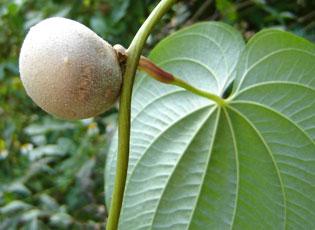Dioscorea bulbifera L. (ITIS)
Air potato, Air potato vine, air yam, bitter yam
Asia and Africa (Overholt et al. 2003)
First observed in the U.S. in Alabama in the 1770s; first introduced to Florida in 1905 (Gucker 2009)
Originally cultivated as a possible food crop and ornamental in the 1800s (Miller et al. 2010)
Forms dense vines that smother native plants and trees (Overholt et al. 2008)

Air potato, bulbils
Photo by Karen Brown; University of Florida
Find more images
Spotlights
Distribution / Maps / Survey Status
All Resources
Selected Resources
The section below contains highly relevant resources for this species, organized by source.
Partnership
Federal Government
International Government
State and Local Government
Gucker, C.L. 2009. Dioscorea spp. In: Fire Effects Information System. U.S. Department of Agriculture, Forest Service, Rocky Mountain Research Station, Fire Sciences Laboratory.
Integrated Taxonomic Information System. Dioscorea bulbifera. [Accessed Mar 12, 2023].
Miller, J.H., E.B, Chambliss, and N.J. Loewenstein. 2010. Climbing Yams. In: A field guide for the identification of invasive plants in southern forests [PDF, 13.27 MB]. (General Technical Report SRS-119)
Overholt, W. A., C. Hughes, C. Wallace, and E. C. Morgan. 2003. Origin of air potato identified [PDF, 99 KB]. Wildlands Weeds 7:9.
Overholt, W.A., K. Langeland, E.C. Morgan, J. Moll, and K. Gioeli. 2008. Air Potato in Florida [PDF, 113 KB]. University of Florida, IFAS Extension.
